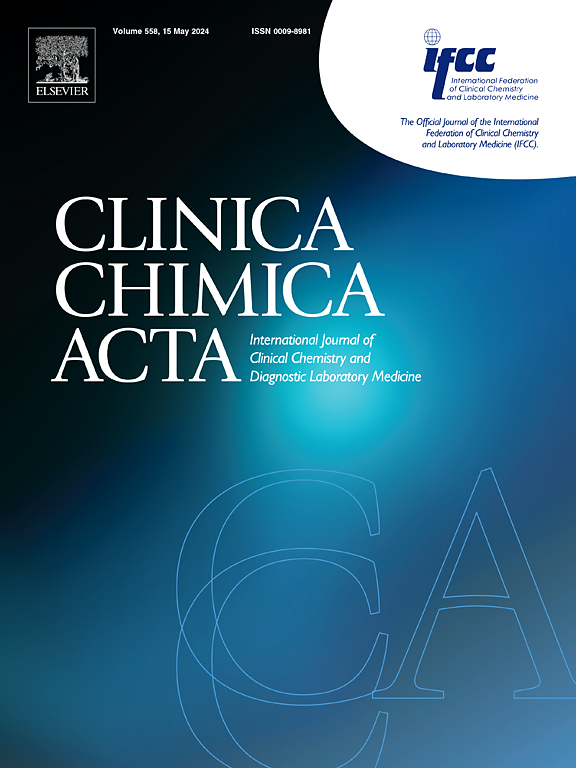Fingernail analysis in diagnosis and management of diabetes mellitus
IF 2.9
3区 医学
Q2 MEDICAL LABORATORY TECHNOLOGY
引用次数: 0
Abstract
This systematic review elucidates the role of fingernail analysis in the diagnosis and management of diabetes mellitus (DM) and its complications. It combines multidisciplinary insights to highlight the potential of non-invasive diabetes assessment, long-term glucose monitoring, and early detection of complications. Covers a wide range of techniques, including spectroscopy and imaging methods such as near-infrared spectroscopy (NIR), Raman spectroscopy (RS), laser-induced breakdown spectroscopy (LIBS), Fourier transform infrared spectroscopy (FTIR), X-ray fluorescence spectroscopy (XRF), as well as microscopy and elemental analysis techniques such as dermoscopy, nail fold video capillaroscopy (NVC), inductively coupled plasma mass spectrometry (ICP-MS), and liquid chromatography-tandem mass spectrometry (LC-MS/MS), Nail biochemical analysis and Doppler ultrasound imaging were also included. Special emphasis is placed on glycemic biomarkers such as N-acetyl-DL-leucine enantiomers, carboxymethyl lysine (CML), and advanced glycation end-products (AGEs), which demonstrate robust diagnostic utility. Meta-analytical data indicate that these multimodal approaches yield Area Under the Curve (AUC) values of 0.78 e (CML), and advanced glycation end-products (AGEs), which demonstrate robust diagnostic utility. Meta-analytical data indicate that these multimodal approaches yield Area Under the Curve (AUC) values of from 0.78 to 0.88, underscoring their clinical potential for high sensitivity and specificity discrimination between diabetic and healthy populations Notwithstanding, challenges persist, including instrumentation costs, environmental interferences, and operator expertise requirements. Future directions prioritize elucidating the molecular mechanisms underlying nail-diabetes associations, innovating minimally invasive analytical platforms, and conducting multicenter validation trials to bridge the translational gap.
指甲分析在糖尿病诊断和治疗中的应用
本文系统综述了指甲分析在糖尿病(DM)及其并发症的诊断和治疗中的作用。它结合了多学科的见解,突出了非侵入性糖尿病评估、长期血糖监测和早期发现并发症的潜力。涵盖了广泛的技术,包括光谱和成像方法,如近红外光谱(NIR),拉曼光谱(RS),激光诱导击穿光谱(LIBS),傅立叶变换红外光谱(FTIR), x射线荧光光谱(XRF),以及显微镜和元素分析技术,如皮肤镜,指甲褶视频毛细管镜(NVC),电感耦合等离子体质谱(ICP-MS),液相色谱-串联质谱分析(LC-MS/MS),指甲生化分析和多普勒超声成像。特别强调的是血糖生物标志物,如n -乙酰基- dl -亮氨酸对映体、羧甲基赖氨酸(CML)和晚期糖基化终产物(AGEs),它们显示出强大的诊断效用。荟萃分析数据表明,这些多模式方法的曲线下面积(AUC)值为0.78 e (CML),晚期糖基化终产物(AGEs)显示出强大的诊断效用。荟萃分析数据表明,这些多模式方法的曲线下面积(AUC)值在0.78至0.88之间,强调了它们在糖尿病和健康人群之间高灵敏度和特异性区分的临床潜力。尽管如此,挑战仍然存在,包括仪器成本、环境干扰和操作人员专业知识要求。未来的研究方向是阐明指甲与糖尿病相关的分子机制,创新微创分析平台,开展多中心验证试验以弥合翻译差距。
本文章由计算机程序翻译,如有差异,请以英文原文为准。
求助全文
约1分钟内获得全文
求助全文
来源期刊

Clinica Chimica Acta
医学-医学实验技术
CiteScore
10.10
自引率
2.00%
发文量
1268
审稿时长
23 days
期刊介绍:
The Official Journal of the International Federation of Clinical Chemistry and Laboratory Medicine (IFCC)
Clinica Chimica Acta is a high-quality journal which publishes original Research Communications in the field of clinical chemistry and laboratory medicine, defined as the diagnostic application of chemistry, biochemistry, immunochemistry, biochemical aspects of hematology, toxicology, and molecular biology to the study of human disease in body fluids and cells.
The objective of the journal is to publish novel information leading to a better understanding of biological mechanisms of human diseases, their prevention, diagnosis, and patient management. Reports of an applied clinical character are also welcome. Papers concerned with normal metabolic processes or with constituents of normal cells or body fluids, such as reports of experimental or clinical studies in animals, are only considered when they are clearly and directly relevant to human disease. Evaluation of commercial products have a low priority for publication, unless they are novel or represent a technological breakthrough. Studies dealing with effects of drugs and natural products and studies dealing with the redox status in various diseases are not within the journal''s scope. Development and evaluation of novel analytical methodologies where applicable to diagnostic clinical chemistry and laboratory medicine, including point-of-care testing, and topics on laboratory management and informatics will also be considered. Studies focused on emerging diagnostic technologies and (big) data analysis procedures including digitalization, mobile Health, and artificial Intelligence applied to Laboratory Medicine are also of interest.
 求助内容:
求助内容: 应助结果提醒方式:
应助结果提醒方式:


